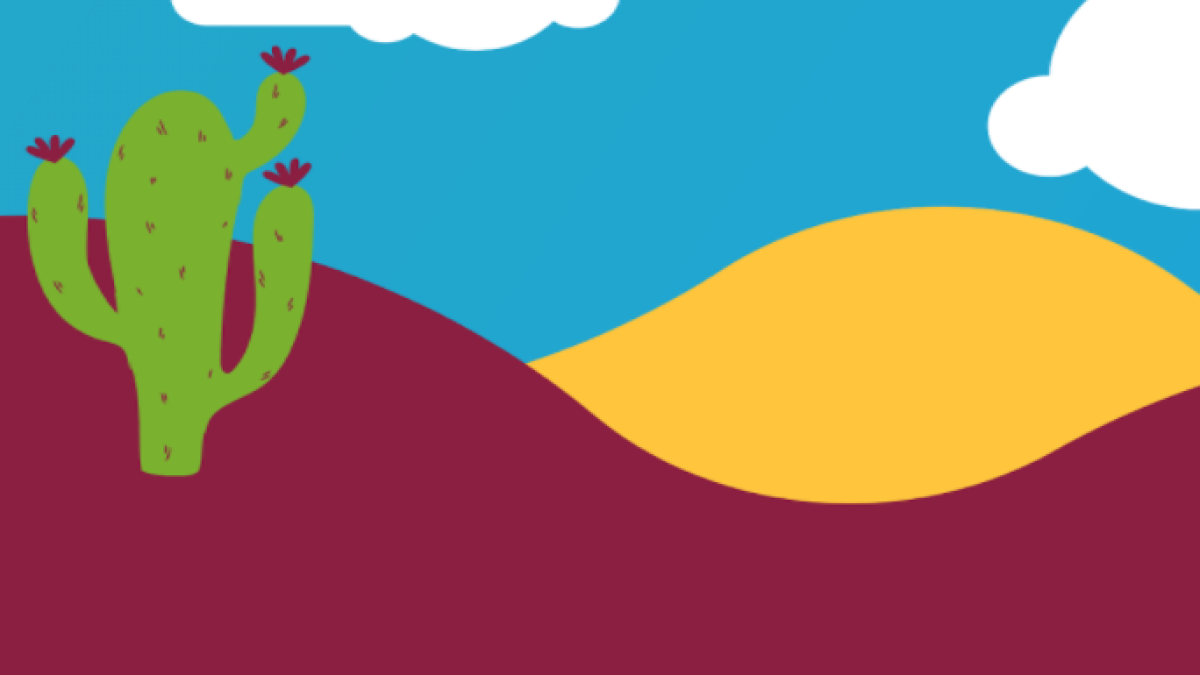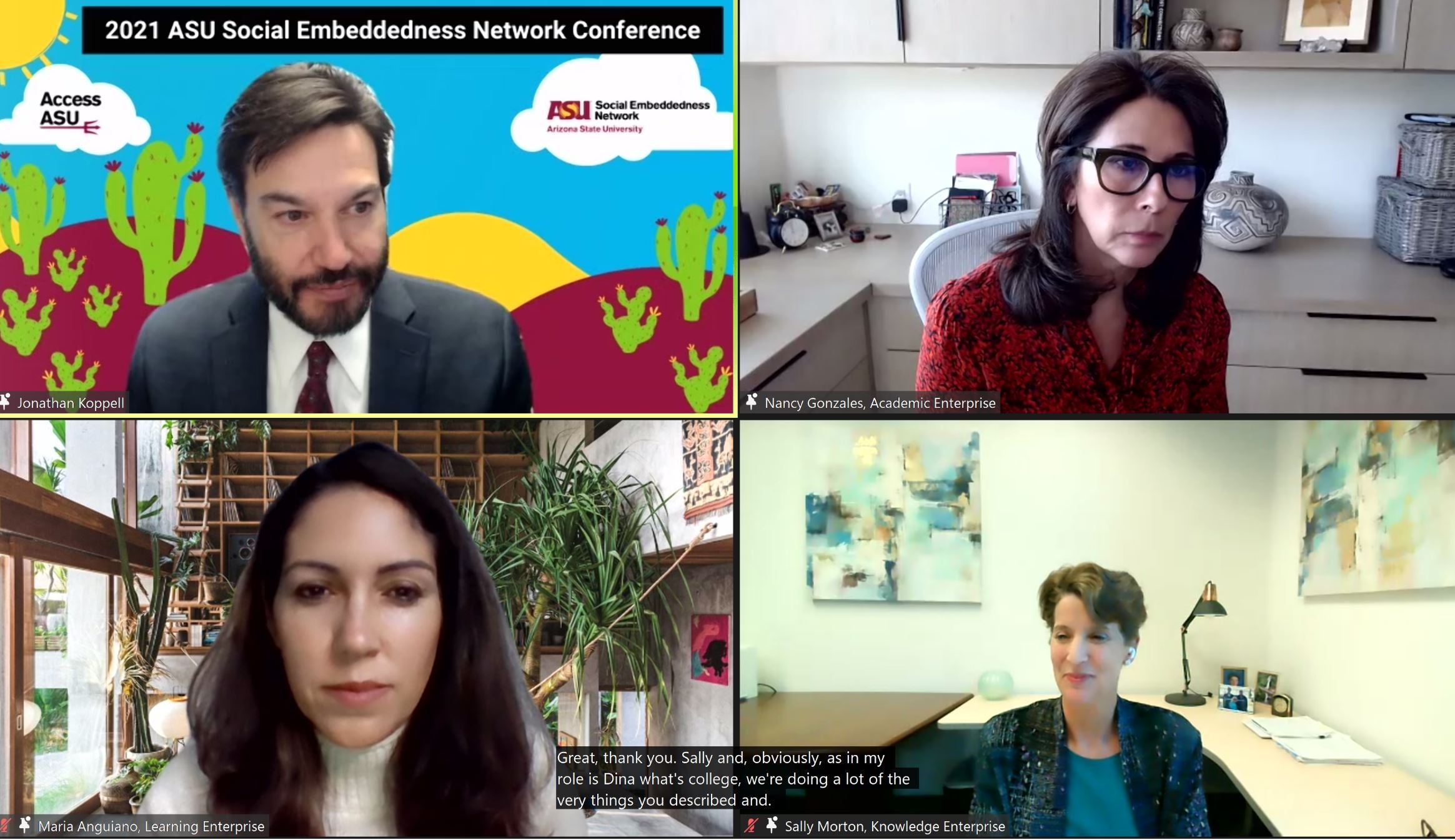ASU's Social Embeddedness Network Conference has record turnout in virtual format

For a second year in row, ASU’s Social Embeddedness Network Conference was held virtually. But the Zoom-based conference was bigger, better, with more participants than years past, proving community-university partnerships can thrive in an array of settings.
The conference, now in its eighth year, started as a luncheon in 2014 — eventually growing to a full-day conference on multiple campuses, then transitioning to a full-day virtual format in 2020 because of the pandemic. This year, due to high interest, the conference was expanded from two days to three, setting a record for participation and turnout, with more than 80 sessions and about 550 registrations, according to event planners. Overall, more than 250 university faculty, staff, students and community partners presented during the March 24–26 conference, which was themed “Planting Seeds for Partnerships and Cultivating Community Collaborations.”
ASU’s three new enterprise leaders kicked off the conference: Nancy Gonzales, provost pro tempore and executive vice president of Academic Enterprise; Sally Morton, executive vice president of Knowledge Enterprise; and Maria Anguiano, executive vice president of Learning Enterprise.
The panel discussion, which was moderated by Jonathan Koppell, vice provost of public service and social impact and dean of Watts College of Public Service and Community Solutions, delved into the meaning of social embeddedness, ASU’s commitment to community partnerships and ways the university can further leverage its assets to become even more socially embedded.

“Social, cultural, community embeddedness is really very personal to me,” Gonzales explained to the panel. “I would say that I wouldn’t have become an academic and a faculty member and stayed within the academy if it weren’t for the fact that I could do that type of research, which is really what I’ve done my entire career.”
Early on in her career, Gonzales said she was advised against this kind of work, but carried on — now researching community, cultural and social factors related to youth development across the lifespan. She values ASU’s strong commitment to social embeddedness and explains that it’s an important component of the educational system.
“We’re finding more and more that the need to have service learning and opportunities out in the community for our students is valuable across all disciplines," she said. "And we’re seeing more efforts to build that into courses, to build that into internships, to build that into a variety of opportunities that we offer our students.”
Faith Dalzell is one of those students who has benefited tremendously from ASU’s vision: to cultivate meaningful and mutually beneficial learning experiences. The senior, who is double-majoring in business and education studies, with an emphasis in organizational leadership through Barrett, The Honors College, shared her experiences during the first day of the conference in a Lightning Talk called “Walking Through the Forest: A Student Perspective on Integrating Social Embeddedness.”
During her time at ASU, Dalzell has worked with a number of community partners, including School Connect AZ, CASA Academy and the city of Tempe. Many of these opportunities came through ASU’s University Service-Learning — courses that let students apply their skills in the real world through community internships or partnerships. It’s in this space, Dalzell believes, that there’s an opportunity to make USL courses universal to all majors.
“As we begin to enter a world that is quickly changing and becoming more and more oriented around the idea of a knowledge economy, these connections from partnerships and exchanges of knowledge become more and more valuable,” she told ASU News. “Social embeddedness brings together various visions and individuals from across different sectors and experiences to help change some of the most complex challenges that face our society today.”
And although those connections and partnerships are happening between ASU and various communities, social embeddedness is playing a large role within the university, especially through ASU’s three new pillars: Academic, Learning and Knowledge enterprises.
“I don’t think any of us works without the other,” Knowledge Enterprise's Morton said during the conference. “Social embeddedness: We often think of people outside the university, but, I think, it’s also how we work together within the university. So I actually think we are an example of social embeddedness — the new structure, which is purposely designed by the university to further its charter and its aspirations.”
Learning Enterprise's Anguiano added that social embeddedness is about being responsive to a community’s needs.
“The vision of Learning Enterprise is to really help ensure universal access to educational opportunities at every stage of a person’s life — no matter where they are,” Anguiano said to the panel. “It’s definitely born out of all the work that’s already been done at ASU, and we hope to even further the work and get even more socially embedded.”
Questions are often the best starting point when it comes to building community partnerships. It was a recipe for success for Lauren Weidner, a forensic entomologist and assistant professor in the School of Mathematical and Natural Sciences in the New College of Interdisciplinary Arts and Sciences. She looks at the insects found at crime scenes, helping law enforcement with investigations. But in order to further her research and training, Weidner needed supplies. She turned to social media to ask for help and quickly found a local farm that was looking to eliminate its food waste, to donate materials for her research. A win for Weidner, who tells ASU News that one of her goals for the field of forensic science is to help the community through science.
“Being able to have the community involved with the research used to support this field really strengthens the field as a whole,” she said.
With the right amount of research and training, Weidner hopes the insects she studies will continue to provide clearer evidence for law enforcement and be used to exonerate individuals who are wrongfully imprisoned.
“What I’m trying to do with these insects is reach the point where we’re not having wrongful convictions; we’re stopping that prematurely. One of the ways we’re doing this is providing forensic entomology training to the law enforcement and forensic practitioner communities.”
Big ideas, one collaborative space
Despite the challenges of staying socially embedded virtually in 2020, ASU’s Social Embeddedness Network launched Collaboratory — a digital platform that tracks university-community partnerships. The online reporting tool provides the university more of a real-time snapshot of the work being done by faculty, staff and community members.
In years past, the work was tracked through an annual survey. Now, faculty and staff can input data at any time, while searching the database for other partners. The tool also empowers community members to initiate collaborations by serving as a map of ASU’s partnerships throughout its campuses, across Arizona, around the globe — and now — even the university’s virtual collaborations. The tool also helps the community be advocates for their socially embedded work as well.
“Community partners are recognized for their contributions and role in the work we do together,” said Christina Ngo, director of social embeddedness at ASU and the person who spearheaded the launch of Collaboratory and planned this year’s Social Embeddedness Network Conference. “The database also helps community partners identify possible faculty and staff who might make excellent, values-aligned collaborators. It encourages community partners to consider how and what types of additional connections they might make with ASU.”
Ngo adds that partnership is a core value of a publicly engaged institution, and a necessity within higher education.
“Socially embedded activities serve as opportunities to bring together seemingly disparate individuals and organizations with the expectation that they will work together around a shared vision,” Ngo said. “It also reinforces that we must acknowledge and recognize the important contributions, knowledge and expertise of our community partners. Social embeddedness allows us to practice deep listening and really hear what communities want and need.”
So far, more than 1,000 activities have been logged on the Collaboratory database. Additionally, ASU is also tracking how the university’s socially embedded activities aligns with the United Nations’ 17 Sustainable Development Goals, which were adopted by all member states in 2015 and provide a blueprint for a more peaceful, prosperous and sustainable future.
One of those goals (No. 11) is to build sustainable cities and communities. As more and more companies are looking to become more sustainable, ASU is looking for innovative ways to advance those shared visions through private-sector partnerships.
“When it comes to shared goals, such as sustainability and our global future, we have so much to learn from each other,” said Amy Scoville-Weaver, program manager with ASU’s Corporate Engagement and Strategic Partnerships whose presentation at the conference was titled “Partnering with Industry for a Sustainable World.” “Companies want to learn how we’ve led the way, and we want to ensure our expertise is applied and our students are mentored and deployed to solve the issues that impact us all — like the climate crisis. Nurturing and advancing these kinds of partnerships also helps us show our university commitment to improving our world.”
In a pandemic year, the flexibility and adaptability brought on by the transition to a virtual world led Scoville-Weaver and her team to success, with the development of a new corporate partnership — achieved entirely over Zoom. (She could not share the name of the corporate partner yet because of a nondisclosure agreement.) She believes there’s opportunity for virtual collaboration moving forward and is excited about adding virtual tools to the larger toolbox.
“I’ve found our new virtual reality to be an enormous opportunity for camaraderie and relationship building with leaders of Fortune 500 companies that — honestly — I might have been intimidated by pre-pandemic. It has been humanizing and level-setting.”
Virtually, the Social Embeddedness Network Conference has also seen some successes. This year, more community partners were able to present at the conference than ever before. In the year to come, ASU’s social embeddedness director hopes the Collaboratory database will only increase the connectivity between the university and its many important community collaborators.
Ngo shares, “ASU is Collaboratory’s largest higher education partner, and one of my goals is to be able to leverage our fantastic subject-matter experts, including staff, faculty, students and community partners, to help improve the tool for our use as well as to help other institutions seeking ways to organize and map their social embeddedness work.”
To watch some of the presentations from the 2021 Social Embeddedness Network Conference, visit the ASU social embeddedness YouTube page.
More Environment and sustainability

'Earth Day Amplified' promotes power of collective action
Everybody loves the concept of sustainability. They want to do their part, and the chance to say they’ve contributed to the well-being our of planet.But what does that actually mean?Arizona State…

Rethinking Water West conference explores sustainable solutions
How do you secure a future with clean, affordable water for fast-growing populations in places that are contending with unending drought, rising heat and a lot of outdated water supply infrastructure…
Meet the young students who designed an ocean-cleaning robot
A classroom in the middle of the Sonoran Desert might be the last place you’d expect to find ocean research — but that’s exactly what’s happening at Harvest Preparatory Academy in Yuma, Arizona.…

